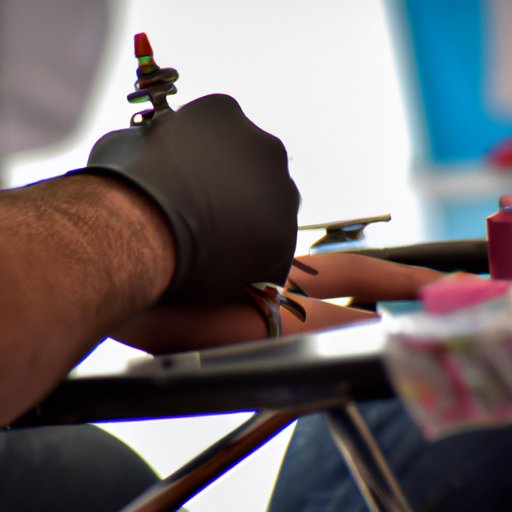
Introduction
Tattoos have become increasingly popular over the past few decades. Some people get tattoos to commemorate special events or dates, and others get them simply for aesthetic value. If you’re considering getting a tattoo, it’s important to know exactly what you’re getting into. This guide for beginners takes you through the process from start to finish, and includes tips on pain management, aftercare, and potential risks.
Step-by-step guide to prepare for a tattoo
The first step to getting a tattoo is researching different designs and styles to find one that speaks to you. You also want to consider the symbolism behind a design before getting it inked onto your skin. After you’ve found a design you like, it’s important to find a reputable tattoo artist who can bring your idea to life. To do this, ask around for recommendations, check out portfolios, and visit studios to get a feel for their level of professionalism and hygiene standards. Once you’ve chosen your artist, they’ll provide you with a stencil or outline of the design, so you can see what it will look like on your skin. Make sure you’re happy with the placement and size before the actual tattooing begins.
It’s important to care for your skin before your tattoo session. Keep the skin hydrated and moisturized in the weeks leading up to the appointment. Avoiding sunburn or cuts on the area is also critical, as it can make the tattooing process extremely uncomfortable.
Tips on how to handle tattoo pain
It’s important to keep in mind that the pain level associated with getting a tattoo will vary depending on the size, placement, and complexity of the design. Small tattoos typically don’t hurt as much, while larger and more complex designs can be more uncomfortable. If you’re worried about the pain, consider purchasing numbing cream, which can be applied to the skin before the tattooing begins. It’s also important to take breaks during the session if you need them. Your tattoo artist will understand if you need to stop for a few minutes to take a breather.
Deep breathing exercises and meditation can also be helpful for managing tattoo pain. By focusing on your breath, you might find the pain is lessened. You can also distract yourself by bringing a friend with you or listening to music during your session.
After-care for your tattoo
Aftercare for a tattoo is an essential part of the process. Once the tattoo is complete, the artist will cover the area with a bandage or plastic wrap. It’s important to keep this intact for at least a few hours after the session is complete, and then remove it gently to avoid any skin irritation or abrasion.
After removing the wrappings, clean the tattooed area gently with mild soap and lukewarm water. Avoid using hot water or harsh soaps, which can irritate the skin. After cleaning, gently pat the area dry with a clean towel. Apply a thin layer of ointment or moisturizer to the area to keep the skin hydrated and promote healing. It’s also important to avoid exposing the tattoo to any direct sunlight, swimming, or soaking in a bathtub or hot tub for the first couple of weeks to reduce the risk of infection.
How to decide on a tattoo design
When it comes to choosing a tattoo design, you have plenty of options to consider. It’s important to research different styles and meanings to find a design that speaks to you and fits with your personality. Working with a talented tattoo artist can also help, as they can often help bring your ideas to life in unique ways.
Potential risks associated with tattoos
One of the most significant risks associated with getting a tattoo is infection. This can occur if the needle or equipment used isn’t cleaned or sterilized correctly. Allergic reactions can also occur if the ink used contains certain substances, such as metals like iron or nickel. Discoloration of the tattooed skin is another possible side effect, although this is more commonly seen with older tattoos.
To minimize these risks, it’s important to choose a reputable studio and artist and hire someone who follows proper hygiene techniques. Speak with your artist about the type of ink they’ll use, and do research on the brand to make sure it’s safe and free of any allergens. Be sure to follow aftercare instructions carefully to ensure the tattoo heals properly and reduces the risk of infection or discoloration.
Different types of tattoos available
There are a variety of tattoo styles to consider, from traditional tattoos to more modern styles like watercolor and abstract designs. Different cultures also have specific designs and meanings associated with tattoos. Doing your research can help you find a style that fits your personality and style. Traditional styles are often bold and classic, while watercolor tattoos involve a more painterly and abstract approach. Cultural tattoos can also be a good way to incorporate symbols or designs that have a deeper meaning for you.
The history of tattoos across various cultures
Tattoos have been around for centuries, and have been used by various cultures for a multitude of reasons. In some cultures, tattoos were considered a rite of passage or a symbol of status or rank. In others, they might have been used to ward off evil spirits or protect the wearer. Tattoos have been used across various cultures, including Maori, Polynesian, and Native American tribes.
Conclusion
Getting a tattoo is a big decision, but with proper research and preparation, you can ensure that the experience is positive and free from complications. It’s important to take the time to choose a design and artist that fits your style and personality, and follow aftercare instructions carefully. By doing so, you can enjoy your tattoo for many years to come.





